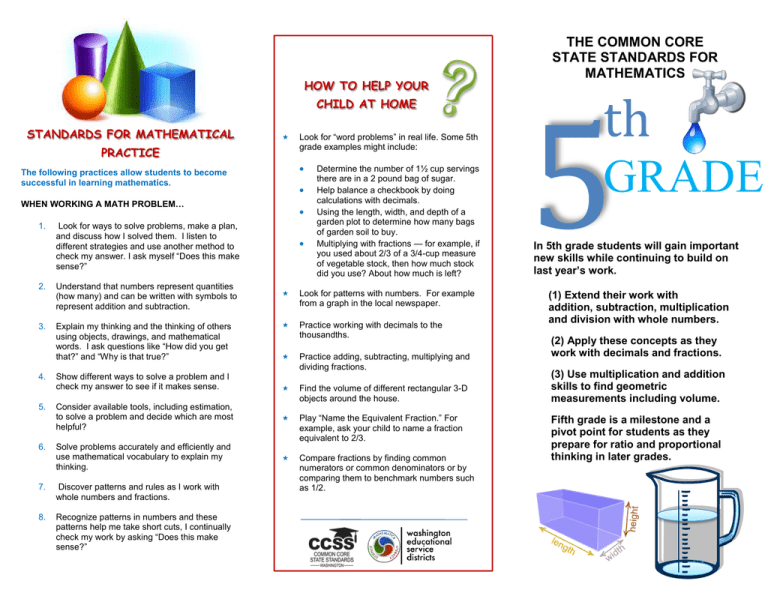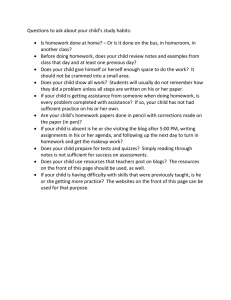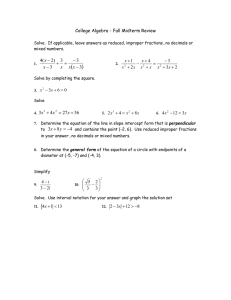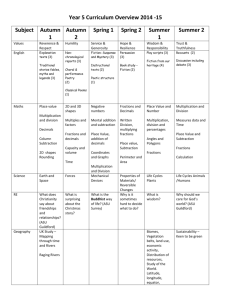5 th GRADE
advertisement

HOW TO HELP YOUR
CHILD AT HOME
STANDARDS FOR MATHEMATICAL
PRACTICE
The following practices allow students to become
successful in learning mathematics.
WHEN WORKING A MATH PROBLEM…
1.
Understand that numbers represent quantities
(how many) and can be written with symbols to
represent addition and subtraction.
3.
Explain my thinking and the thinking of others
using objects, drawings, and mathematical
words. I ask questions like “How did you get
that?” and “Why is that true?”
4.
5.
6.
Look for ways to solve problems, make a plan,
and discuss how I solved them. I listen to
different strategies and use another method to
check my answer. I ask myself “Does this make
sense?”
2.
Look for “word problems” in real life. Some 5th
grade examples might include:
Determine the number of 1½ cup servings
there are in a 2 pound bag of sugar.
Help balance a checkbook by doing
calculations with decimals.
Using the length, width, and depth of a
garden plot to determine how many bags
of garden soil to buy.
Multiplying with fractions — for example, if
you used about 2/3 of a 3/4-cup measure
of vegetable stock, then how much stock
did you use? About how much is left?
Look for patterns with numbers. For example
from a graph in the local newspaper.
Practice working with decimals to the
thousandths.
Practice adding, subtracting, multiplying and
dividing fractions.
Find the volume of different rectangular 3-D
objects around the house.
Consider available tools, including estimation,
to solve a problem and decide which are most
helpful?
Play “Name the Equivalent Fraction.” For
example, ask your child to name a fraction
equivalent to 2/3.
Solve problems accurately and efficiently and
use mathematical vocabulary to explain my
thinking.
Compare fractions by finding common
numerators or common denominators or by
comparing them to benchmark numbers such
as 1/2.
Show different ways to solve a problem and I
check my answer to see if it makes sense.
7.
Discover patterns and rules as I work with
whole numbers and fractions.
8.
Recognize patterns in numbers and these
patterns help me take short cuts, I continually
check my work by asking “Does this make
sense?”
THE COMMON CORE
STATE STANDARDS FOR
MATHEMATICS
5
th
GRADE
In 5th grade students will gain important
new skills while continuing to build on
last year’s work.
(1) Extend their work with
addition, subtraction, multiplication
and division with whole numbers.
(2) Apply these concepts as they
work with decimals and fractions.
(3) Use multiplication and addition
skills to find geometric
measurements including volume.
Fifth grade is a milestone and a
pivot point for students as they
prepare for ratio and proportional
thinking in later grades.
(17+33)
5=10
OPERATIONS AND ALGEBRAIC
THINKING
Fifth grade students begin to use parentheses
to write and solve equations in preparation for
middle school mathematics. They extend their
work to look at a relationship between two
patterns preparing a foundation for algebra.
NUMBER AND OPERATIONS-FRACTIONS
Determine the volume of concrete
needed to build the steps in the
diagram below.
I can solve problems like these:
Sonia had 2 1/3 candy bars. She promised her
brother that she would give him ½ of a candy
bar. How much will she have left after she gives
her brother the amount she promised?
I can use parentheses, brackets, or
braces to show my understanding of the
order of operations.
I can solve real world and mathematical
problems involving volume.
EXAMPLES:
EXAMPLES:
Fifth grade students extend the fraction work to addition
and subtraction of fractions with unlike denominators and
mixed numbers. Students work with area models to
understand multiplication and division of fractions.
Steve’s lawn is 1 ¾ acres. His neighbor’s lawn
is ½ the size of his lawn. How many acres is his
neighbor’s lawn?
I can solve real world problems involving division of
fractions using a model.
(26 + 18) 4=11
{[2 x (3+5)] – 9} + [5 x (23-18)]=32
How many 1/3 cup servings are in 2 cups of
raisins?
GEOMETRY
Fifth grade students graph points, interpret the data
and sort two-dimensional figures in categories
based on their properties.
EXAMPLES:
I can identify a relationship between two
numerical patterns.
2 cups
NUMBER AND OPERATIONS
I can interpret coordinate values of points in
the context of real world and mathematical
problems
Use the graph below to determine
how much money Jack makes after
working exactly 9 hours.
Fifth grade students extend the number system to
decimals and learn to use them in basic operations
of addition, subtraction, multiplication and division.
They become fluent with multi-digit multiplication
and begin to learn division strategies.
EXAMPLES:
I can explain the patterns in multiplying by 10,
100, 1000, etc. by the number of zeros in the
product.
I can explain the placement of the decimal
point when a decimal is multiplied or divided by
a power of 10.
EARNINGS (in dollars)
IN BASE TEN
MEASUREMENT AND DATA
Fifth grade students should be able to make line plots and
analyze the data. They will also be able to measure
volume of objects using multiplication.
I can convert measurements to solve multi-step, real
world problems.
I can add, subtract, multiply or divide fractions to solve
problems with information presented in line plots.
16
12
8
4
0
EXAMPLES:
20
2
4
6
8 10
HOURS WORKED
12
I can use attributes of 2 dimensional figures to
determine into which category they belong.
For example:
All rectangles have four right angles
and squares are rectangles, so all
squares have four right angles.




